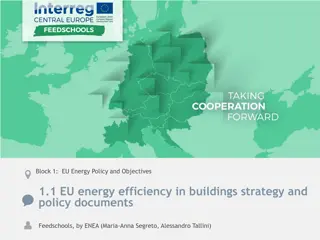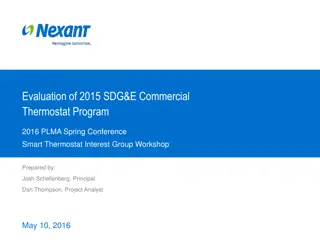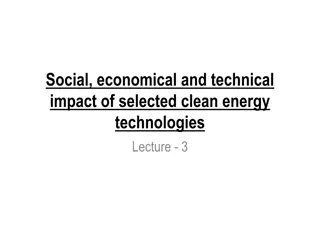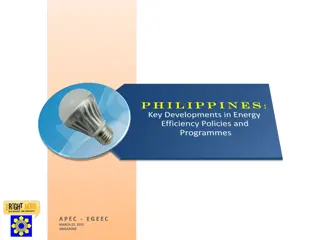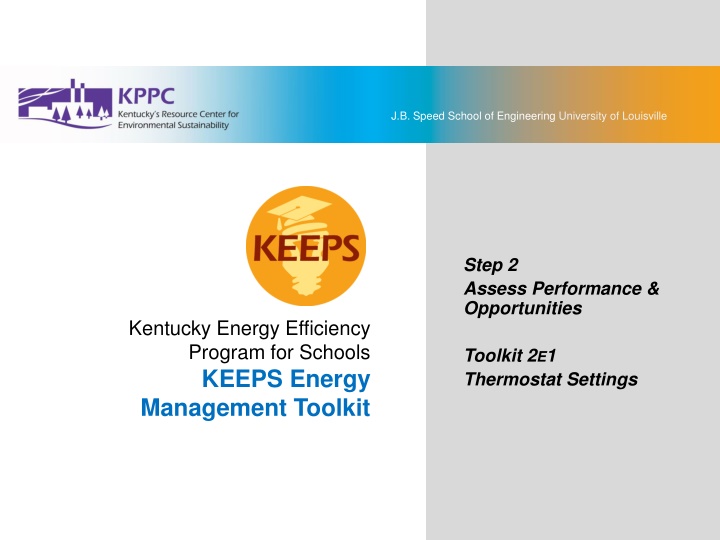
Efficient Thermostat Settings for Energy Management in Schools
Learn how to assess and optimize thermostat settings for efficient energy management in school buildings. Find out about setting setbacks/setups, considering building usage, unique system capabilities, and more to maximize energy savings while ensuring comfort and safety.
Download Presentation

Please find below an Image/Link to download the presentation.
The content on the website is provided AS IS for your information and personal use only. It may not be sold, licensed, or shared on other websites without obtaining consent from the author. If you encounter any issues during the download, it is possible that the publisher has removed the file from their server.
You are allowed to download the files provided on this website for personal or commercial use, subject to the condition that they are used lawfully. All files are the property of their respective owners.
The content on the website is provided AS IS for your information and personal use only. It may not be sold, licensed, or shared on other websites without obtaining consent from the author.
E N D
Presentation Transcript
J.B. Speed School of Engineering University of Louisville KEEPS Energy Management Toolkit Step 2: Assess Performance & Opportunities Toolkit 2E1: Thermostat Settings Step 2 Assess Performance & Opportunities Kentucky Energy Efficiency Program for Schools KEEPS Energy Management Toolkit Toolkit 2E1 Thermostat Settings
KEEPS KEEPS Energy Management Toolkit KEEPS Energy Management Toolkit Toolkit 2E1: Thermostat Settings Toolkit 2E1 Thermostat Settings 2 KPPC Kentucky s Resource Center for Environmental Sustainability 2
7-Step Energy Management Process 1. Make the Commitment 2. Assess Performance and Opportunities 3. Set Performance Goals 4. Create an Action Plan 5. Implement the Action Plan 6. Evaluate Progress 7. Recognize Achievements 3 KPPC Kentucky s Resource Center for Environmental Sustainability 3
Thermostat Settings Overview Knowing Thermostat System s Capabilities Tips for Establishing Setbacks/Setups KEEPS On-site Energy Assessment Form KEEPS Energy Assessment Tool KEEPS Assessment Report Thermostat Setting Recommendations 4 KPPC Kentucky s Resource Center for Environmental Sustainability 4
Knowing Systems Capabilities Every building is unique, and some thermostat setbacks/setups may not be applicable. Work with facility manager, and make adjustments accordingly. Setbacks/setups depend on: Building usage Equipment s recovery capability Avoidance of building damage (pipe freeze/mold) KPPC Kentucky s Resource Center for Environmental Sustainability
Establishing Setbacks/Setups Schools can be setback/setup for up to 2/3 of the year Condition the building during greatest occupancy Consider initiating system setback/setup 1-2 hours before the majority of occupants exit KPPC Kentucky s Resource Center for Environmental Sustainability
Establishing Setbacks/Setups (cont.) What setpoints should building be set at when occupied by only a few people? Not recommended to set thermostats below 55 F to prevent pipe freeze or above 83 F to prevent excessive humidity. KPPC Kentucky s Resource Center for Environmental Sustainability
Thermostat Settings Data Collection KPPC Kentucky s Resource Center for Environmental Sustainability
KEEPS Thermostat Settings Tool Helps determine proper thermostat setpoints for school buildings/facilities Based on varying building usage patterns Calculations based on 1% heating and cooling savings per degree, per 8-hour setback See U.S. DOE s Energy Savers website KPPC Kentucky s Resource Center for Environmental Sustainability 9
KEEPS Thermostat Settings Tool: Instructions KPPC Kentucky s Resource Center for Environmental Sustainability
KEEPS Report Input Locate HVAC & Controls in the KEEPS Assessment Report and modify respective figures and other necessary words/sentences for your specific school. Modify the inset box with the results calculated from the KEEPS Thermostat Settings Tool. KPPC Kentucky s Resource Center for Environmental Sustainability 11
Managing Thermostat Settings Building Automation System (BAS) Gives control to only energy manager, facility manager, superintendent Programmable thermostats Gives occupants control and responsibility Limited-adjustment thermostats Gives occupants limited control within 1 3 degrees Dummy thermostats Gives occupants no real control, only psychological feel of control Lockout covers Gives occupants no control 12 KPPC Kentucky s Resource Center for Environmental Sustainability
Resources Available for download from the KEEPS Toolkit Library http://www.kppc.org/KEEPS 13 KPPC Kentucky s Resource Center for Environmental Sustainability 13
J.B. Speed School of Engineering University of Louisville End of Presen tation Kentucky Energy Efficiency Program for Schools (502) 852-0965 www.kppc.org/KEEPS KEEPS is funded by the American Recovery and Reinvestment Act through the combined efforts of the Kentucky Department for Energy Development and Independence, the U.S. Department of Energy and KPPC.










